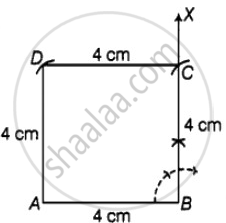Advertisements
Advertisements
प्रश्न
Construct a square of side 4 cm.
उत्तर
We know that, all sides of a square are equal and each side is perpendicular to adjacent side.
So, AB = BC = CD = DA = 4 cm
Steps of construction:
Step I: Draw `bar(AB)` = 4 cm.
Step II: At B, draw `bar(BX)` that is ∠ABX = 90°.
Step III: From `bar(BX)`, cut-off BC = 4 cm.
Step IV: With centre C and radius = 4 cm, drawn an arc.
Step V: With centre A and radius = 4 cm, draw another arc to intersect the previous arc at D.
Step VI: Join DA and CD.
Hence, ABCD is the required square.
APPEARS IN
संबंधित प्रश्न
Diagonals of a square IJKL intersects at point M, Find the measures of ∠IMJ, ∠JIK and ∠LJK .
State with reason whether the following statement is ‘true’ or ‘false’.
Every square is a rectangle.
State with reason whether the following statement is ‘true’ or ‘false’.
Every square is a rhombus.
If the diagonal of a square is `12 sqrt 2` cm then the perimeter of square is ______.
If diagonal of a square is 13 cm then find its side.
PQRS is a square. PR and SQ intersect at O. Then ∠POQ is a ______.
______ is a regular quadrilateral.
A rectangle whose adjacent sides are equal becomes a ______.
Every square is a rhombus.
Construct a square in which each diagonal is 5 cm long.
